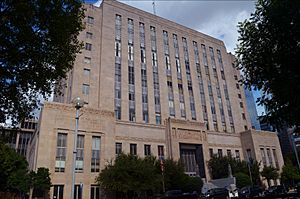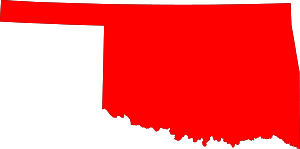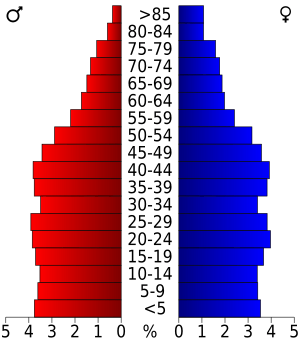Oklahoma County, Oklahoma facts for kids
Quick facts for kids
Oklahoma County
|
||
|---|---|---|

|
||
|
||

Location within the U.S. state of Oklahoma
|
||
 Oklahoma's location within the U.S. |
||
| Country | ||
| State | ||
| Founded | 1890 | |
| Seat | Oklahoma City | |
| Largest city | Oklahoma City | |
| Area | ||
| • Total | 718 sq mi (1,860 km2) | |
| • Land | 708.82 sq mi (1,835.8 km2) | |
| • Water | 9.6 sq mi (25 km2) 1.3%% | |
| Population
(2020)
|
||
| • Total | 796,292 |
|
| • Density | 1,123/sq mi (434/km2) | |
| Time zone | UTC−6 (Central) | |
| • Summer (DST) | UTC−5 (CDT) | |
| Congressional districts | 3rd, 4th, 5th | |
Oklahoma County is a county located in the central part of the U.S. state of Oklahoma. As of the 2020 census, the population was 796,292, making it the most populous county in Oklahoma. The county seat is Oklahoma City, the state capital and largest city. Oklahoma County is at the heart of the Oklahoma City metropolitan statistical area.
Oklahoma County is one of seven counties in the United States to share the same name as the state it is located in (the other six being Arkansas County, Hawaii County, Idaho County, Iowa County, New York County (Manhattan), and Utah County), and the only one of the seven to contain the state capital, and one of two to contain a city of the same name as well.
Contents
History
The area that would someday be called Oklahoma County was originally inhabited by members of the indigenous nations of the Southern Plains, but by the 1830s the land would become part of the territory assigned to the Seminoles and Creeks after their removal from their ancestral lands in the Southeastern USA.
As a result of the Reconstruction era treaties signed between the US government and the Seminole and Creek nations in 1866, the land was taken from tribal jurisdiction but not assigned to other tribal governments, which in time led it to be called the Unassigned Lands. In 1889, the US federal government held a land run for the Unassigned lands, which led to the rapid settlement of the area.
By 1890, Oklahoma County was called "County Two" and was one of seven counties established by the Organic Act of 1890.
County business initially took place in a building at the intersection of California Avenue and Robinson Street until the construction of the first Oklahoma County Courthouse at 520 West Main Street in the 1900s. In 1937, the county government was moved to a building at 321 Park Avenue, which now serves only as the county courthouse.
Geography
According to the U.S. Census Bureau, the county has a total area of 718 square miles (1,860 km2), of which 709 square miles (1,840 km2) is land and 9.6 square miles (25 km2) (1.3%) is water.
Transit
- Embark
- Oklahoma City Streetcar
- Flixbus
- Greyhound Lines
- Amtrak (Heartland Flyer) at Oklahoma City station
Major highways
 I-35
I-35 I-40
I-40 I-44
I-44 I-235
I-235 I-240
I-240 I-335
I-335 I-344
I-344 US-62
US-62 US-66
US-66 US-77
US-77 US-270
US-270 Turner Turnpike
Turner Turnpike Kilpatrick Turnpike
Kilpatrick Turnpike Kickapoo Turnpike
Kickapoo Turnpike SH-3
SH-3 SH-3A
SH-3A SH-66
SH-66 SH-74
SH-74 SH-77H
SH-77H SH-152
SH-152 SH-270
SH-270
Adjacent counties
- Logan County (north)
- Lincoln County (east)
- Pottawatomie County (southeast)
- Cleveland County (south)
- Canadian County (west)
- Kingfisher County (northwest)
National protected area
Demographics
| Historical population | |||
|---|---|---|---|
| Census | Pop. | %± | |
| 1890 | 11,742 | — | |
| 1900 | 25,915 | 120.7% | |
| 1910 | 85,232 | 228.9% | |
| 1920 | 116,307 | 36.5% | |
| 1930 | 221,738 | 90.6% | |
| 1940 | 244,159 | 10.1% | |
| 1950 | 325,352 | 33.3% | |
| 1960 | 439,506 | 35.1% | |
| 1970 | 526,805 | 19.9% | |
| 1980 | 568,933 | 8.0% | |
| 1990 | 599,611 | 5.4% | |
| 2000 | 660,448 | 10.1% | |
| 2010 | 718,633 | 8.8% | |
| 2020 | 796,292 | 10.8% | |
| 2023 (est.) | 808,866 | 12.6% | |
| U.S. Decennial Census 1790-1960 1900-1990 1990-2000 2010 |
|||
According to the 2010 U.S. census, there were 718,633 people, 277,615 households, and 172,572 families residing in the county. The population density was 1,013 inhabitants per square mile (391/km2). There were 319,828 housing units at an average density of 416 units per square mile (161 units/km2). The racial makeup of the county was 64.6% White, 15.4% Black or African American, 3.5% Native American, 3% Asian, 0.1% Pacific Islander, 8.1% from other races, and 5.3% from two or more races; 15.1% of the population were Hispanic or Latino of any race. Throughout its population, 12.4% were of German, 12.3% Mexican, 10.1% Irish, 7.9% English, and 7.7% American ancestries according to the 2010 census. 84.4% spoke English and 11.5% Spanish as their first language.
At the 2020 U.S. census, its population increased to 796,292, with a 2022-estimate at 802,559. Racially, the 2021 American Community Survey estimated 54.5% were non-Hispanic white, 15.8% Black or African American, 4.7% Asian, 0.1% Pacific Islander, 5.8% multiracial, and 18.5% Hispanic or Latino of any race. An estimated 10.2% of its population between 2017 and 2021 were foreign-born residents.
In 2010, there were 277,615 households, out of which 28.5% had children under the age of 18 living with them, 43.1% were married couples living together, 15.4% had a female householder with no husband present, and 37.8% were non-families. 31.9% of all households were made up of individuals, and 9.7% had someone living alone who was 65 years of age or older. The average household size was 2.56 and the average family size was 3.26. As of 2021, there were 313,822 households with an average of 2.48 people per household. The median value of an owner-occupied housing unit was $164,000 from 2017 to 2021, and the median gross rent was $929.
In 2010, the median income for a household in the county was $42,916, and the median income for a family was $54,721. The per capita income for the county was $25,723. About 11.70% of families and 15.30% of the population were below the poverty line, including 21.70% of those under age 18 and 8.60% of those age 65 or over. In 2021, its median household income was $58,239 with a per capita income of $34,129. Approximately 16.3% of the population lived at or below the poverty line.
Communities
Cities
Towns
Unincorporated communities
Education
School districts include:
K-12:
- Bethany Public Schools
- Choctaw/Nicoma Park Schools
- Crooked Oak Public Schools
- Deer Creek Public Schools
- Edmond Public Schools
- Harrah Public Schools
- Jones Public Schools
- Luther Public Schools
- McLoud Public Schools
- Midwest City-Del City Schools
- Millwood Public Schools
- Moore Public Schools
- Mustang Public Schools
- Oklahoma City Public Schools
- Piedmont Public Schools
- Putnam City Public Schools
- Western Heights Public Schools
Elementary only:
- Crutcho Public School
- Oakdale Public School
See also
 In Spanish: Condado de Oklahoma para niños
In Spanish: Condado de Oklahoma para niños



